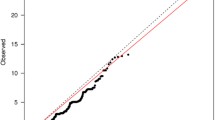Abstract
Semaphorins of the SemaIV family are expressed in neurons and decreased in brains from patients with Alzheimer’s disease (AD). Accumulation of an internalized form of Sema3A is associated with degeneration of neurons, making these molecules candidates for the development of AD. Single nucleotide polymorphisms (SNPs) rs36026860 and rs28469467 in Sema3A as well as rs13284404 and rs11526468 in Sema4D were analyzed in a population of 240 patients with AD compared with 222 age-matched controls. None of SNPs in Sema3A were present, either in patients or controls. The distribution of the Sema4D rs11526468 and rs13284404 SNPs was not significantly different between patients and controls, even stratifying for gender or age at onset. In silico analysis predicted that rs11526468 and rs28469467 are probably damaging. This high degree of conservation of Sema3A suggests a very important role for this protein. However, neither Sema3A nor Sema4D likely influence the susceptibility to AD.

Similar content being viewed by others
References
Tessier-Lavigne M, Goodman CS (1996) The molecular biology of axon guidance. Science 274:1123–1133
Kikutani H, Kumanogoh A (2003) Semaphorins in interactions between T cells and antigen-presenting cells. Nat Rev Immunol 3:159–167
Liu BP, Strittmatter SM (2001) Semaphorin-mediated axonal guidance via Rho-related G proteins. Curr Opin Cell Biol 13:619–626
Behar O, Golden JA, Mashimo H et al (1996) Semaphorin III is needed for normal patterning and growth of nerves, bones and heart. Nature 383:525–528
Kitsukawa T, Shimono A, Kawakami A et al (1995) Overexpression of a membrane protein, neuropilin, in chimeric mice causes anomalies in the cardiovascular system, nervous system and limbs. Development 121:4309–4318
Sekido Y, Bader S, Latif F et al (1996) Human semaphorins A(V) and IV reside in the 3p21.3 small cell lung cancer deletion region and demonstrate distinct expression patterns. Proc Natl Acad Sci USA 93:4120–4125
Soker S, Takashima S, Miao HQ et al (1998) Neuropilin-1 is expressed by endothelial and tumor cells as an isoform-specific receptor for vascular endothelial growth factor. Cell 92:735–745
Semaphorin Nomenclature Committee (1999) Unified nomenclature for semaphorins/collapsins. Cell 97:551–552
Tamagnone L, Comoglio PM (2000) Signalling by semaphorin receptors: cell guidance and beyond. Trends Cell Biol 10:377–383
Delaire S, Billard C, Tordjman R et al (2001) Biological activity of soluble CD100. II. Soluble CD100, similarly to H-SemaIII, inhibits immune cell migration. J Immunol 166:4348–4354
Ji JD, Park-Min KH, Ivashkiv LB (2009) Expression and function of semaphoring 3A and its receptors in human monocyte-derived macrophages. Hum Immunol 70(4):211–217
Good PF, Alapat D, Hsu A et al (2004) A role for semaphorin 3A signaling in the degeneration of hippocampal neurons during Alzheimer’s disease. J Neurochem 91:716–736
Taniguchi Y, Amazaki M, Furuyama T et al (2009) Sema4D deficiency results in an increase in the number of oligodendrocytes in healthy and injured mouse brains. J Neurosci Res 87(13):2833–2841
Hirsch E, Hu LJ, Prigent A et al (1999) Distribution of semaphorin IV in adult human brain. Brain Res 823:67–79
McKhann G, Drachman D, Folstein M et al (1984) Clinical diagnosis of Alzheimer’s disease: Report of the NINCDS-ADRDA Work Group under the auspices of Department of Health and Human Services Task Force on Alzheimer’s Disease. Neurology 34:939–944
Del Bo R, Comi GP, Bresolin N et al (1997) The apolipoprotein E ε4 allele causes a faster decline of cognitive performances in Down’s syndrome subjects. J Neurol Sci 145:87–91
Ng PC, Henikoff S (2003) SIFT: Predicting amino acid changes that affect protein function. Nucleic Acids Res 31:3812–3814
Ferrer-Costa C, Gelpì JL, Zamakola L et al (2005) PMUT: a web-based tool for the annotation of pathological mutations on proteins. Bioinformatics 21:3176–3178
Acknowledgments
This work was supported by grants from IRCCS Ospedale Maggiore Policlinico (Milan), Italian Ministry of Health (PS39 to DG and ES), Monzino Foundation, Ing. Cesare Cusan and Dubini family.
Author information
Authors and Affiliations
Corresponding author
Rights and permissions
About this article
Cite this article
Villa, C., Venturelli, E., Fenoglio, C. et al. Candidate gene analysis of semaphorins in patients with Alzheimer’s disease. Neurol Sci 31, 169–173 (2010). https://doi.org/10.1007/s10072-009-0200-1
Received:
Accepted:
Published:
Issue Date:
DOI: https://doi.org/10.1007/s10072-009-0200-1




